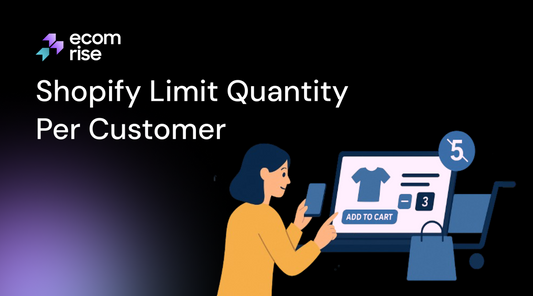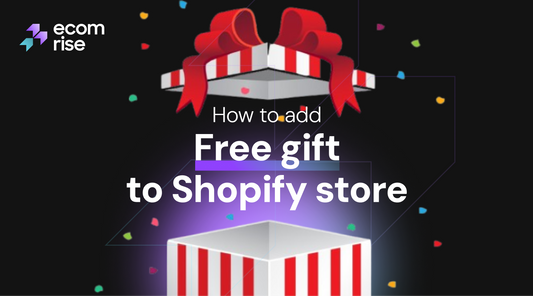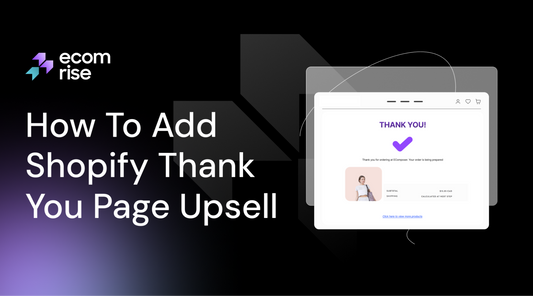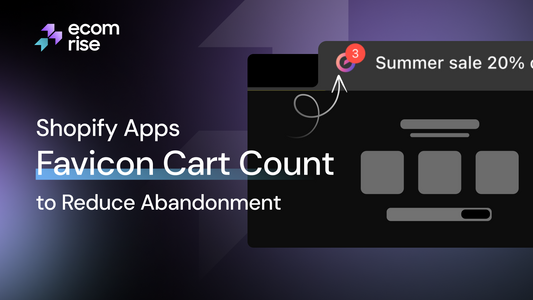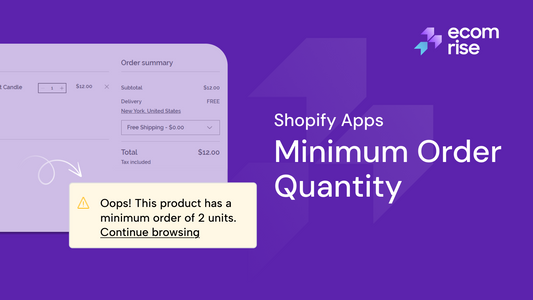Shopify In-Cart Upsells That Work: Strategies, Tools & Tips
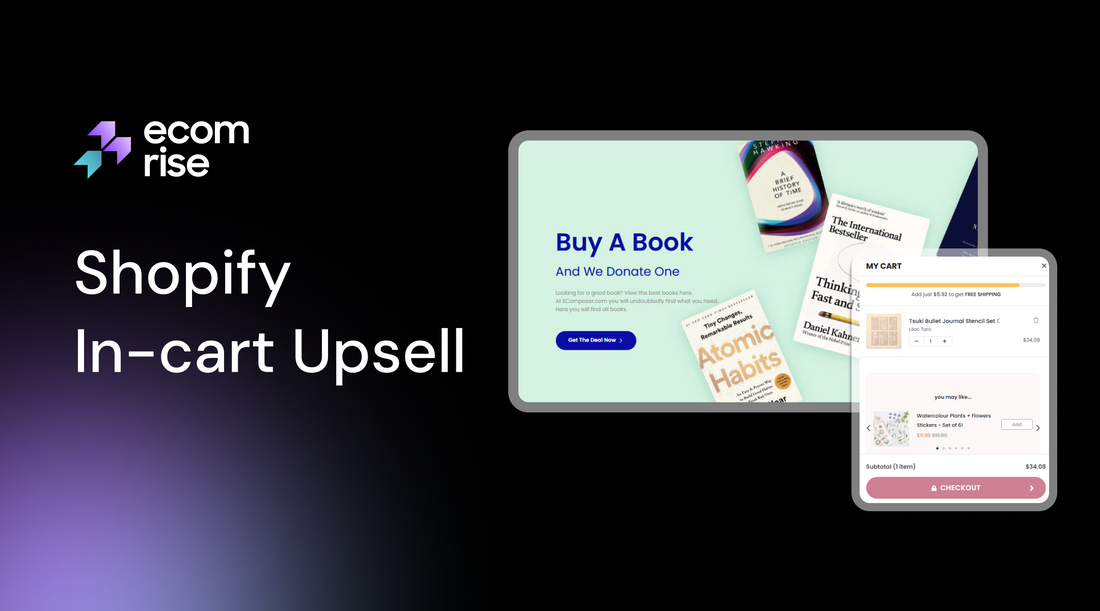
You’ve guided a customer all the way to their cart. They're ready to buy. But what if this moment is your biggest missed opportunity? That's the power of a smart in-cart upsell. It’s not about being pushy; it’s about being helpful while increasing your average order value. In this guide, we'll show you the exact strategies and tools to do it right, turning that final click into a serious profit booster for your Shopify store.
What is In-Cart Upsell on Shopify?
In‑Cart Upsell on Shopify is a tactic or app feature that shows relevant product offers directly in the cart before checkout. It encourages customers to add more items, boosting average order value without disrupting the buying flow.
What exactly is in-cart upsell?
An in-cart upsell is a special offer presented to a customer after they've added an item to their cart, but before they officially check out. It’s to enhance their purchase and, in turn, boost your revenue.
This magic happens in the places where your customer reviews their order before paying:
-
The Cart Drawer / Mini Cart: That slick, slide-out cart that appears on the side of the screen.
-
The Sticky Cart: The little cart icon that often follows a user as they browse, sometimes with a pop-up.
-
The Main Cart Page: The dedicated cart page where users go to view their full order.
Comparison table: In-cart vs Post-purchase vs Product page upsell
In Shopify, you have three primary locations to present an upsell, and each has its own unique psychology and strategic advantage. Let's break them down.
|
Feature |
Product Page Upsell |
In-Cart Upsell (The Sweet Spot) |
Post-Purchase Upsell |
|
When it appears |
Before the customer clicks "Add to Cart." |
After adding to the cart, but before payment (in the cart drawer or page). |
After the customer completes payment, on the "Thank You" page. |
|
Customer's Mindset |
"I'm still considering my options." (Evaluating) |
"I'm ready to buy this." (Committed & High Intent) |
"Phew, my purchase is done!" (Relieved & Satisfied) |
|
Key Advantage |
Can influence the initial product choice towards a higher-value item from the start. |
Capitalizes on peak buying momentum when trust is high and the wallet is out. |
100% risk-free. It can't disrupt the original sale because it's already secured. |
|
Potential Risk |
Decision paralysis. Too many options can overwhelm a shopper and cause them to abandon the page entirely. |
If irrelevant or clunky, it can add friction to the checkout process and feel a bit "salesy." |
Lower visibility. Many customers close the window immediately after making a purchase, missing the opportunity to take advantage of the offer. |
|
Best For |
Clear upgrades (e.g., "Standard vs. Pro" versions), bundles, or variations in materials and sizes. |
Low-cost impulse buys, complementary cross-sells, and hitting a free shipping threshold. |
Risk-free "one-click" offers, subscriptions, digital products, or introducing a new category. |
You don't have to choose just one. In fact, the most sophisticated stores use a mix of all three. However, for most merchants, the in-cart upsell is the perfect place to start.
Why Is In-Cart Upsell Effective?
-
Boost AOV Instantly: Small add-ons across many orders quickly grow revenue - no extra marketing needed.
-
Catch Peak Buying Intent: Shoppers are most ready to buy when adding to cart. A well-timed offer is an easy “yes.”
-
Improve the Experience: Helpful upsells (like a case for a phone) show you care, building trust and loyalty.
-
Drive Discovery: The cart is perfect for showcasing accessories or related items they might’ve missed.
-
Use “Free Shipping” Power: A notice like “$10 more to get free shipping” is a proven nudge to add more.
6 Proven in-cart upsell strategies on Shopify to Increase Sales
Effective in‑cart upsell strategies include free shipping nudges, complementary cross‑sells, quantity discounts, and premium product upgrades. You can also boost AOV with one‑click bundles or low‑cost impulse add‑ons.
The key is placing offers smartly in the cart drawer for quick wins and on the full cart page for higher‑value decisions.
Before going further, a crucial distinction: where your offer appears matters.
-
The Cart Drawer (or Mini Cart): This is the quick, slide-out cart that appears on the side. It's perfect for impulse, speed, and low-friction offers. Think of it as your express lane. A Shopify upsell cart drawer integration is fantastic for quick, one-click additions.
-
The Full Cart Page: This is the dedicated page a customer visits to review their order. Here, you have more space and attention to spare. It's better for more considered decisions, like bundles or higher-value upgrades.
The most successful stores use both. Now, let’s explore the specific Shopify upsell strategies you can deploy in these spaces.
Strategy 1: The "Almost There!" Free Shipping Nudge
This is the undisputed champion of in-cart upsells. It transforms shipping, a cost nobody wants to pay, into a powerful incentive to spend more.
-
What It Is: A dynamic progress bar or message in the cart that shows customers exactly how close they are to unlock free shipping.
-
Why It Works: It leverages a psychological principle called loss aversion. People hate the idea of "wasting" money on shipping fees more than they love the idea of getting a discount. By framing it as a reward they are about to achieve, you gamify the experience. The customer's thought process shifts from "Should I spend more?" to "I just need one small thing to save on shipping!"
-
How to Implement It:
-
Set a Smart Threshold: Analyze your Average Order Value (AOV) to optimize your sales strategy. A good starting point for your free shipping threshold is about 15-20% above your current AOV if your AOV is $50, set free shipping at $60.
-
Make It Visual: Use an app to add a progress bar. Language like "You're just $12.50 away from FREE shipping!" is incredibly effective.
-
The Masterstroke: Don't leave them guessing what to add. Below the progress bar, automatically suggest a few popular, low-cost items (priced around $12.50) that can help them reach their goal. Make it a one-click "Add" process.
Strategy 2: The "Perfect Match" Cross-Sell
This is the most customer-centric approach. You’re not just selling; you’re being a helpful expert.
-
What It Is: Offering a product that perfectly complements an item already in the cart. This is the classic cross-sell vs upsell distinction: a cross-sell is a different product, while a true upsell is a better version of the same product.
-
Why It Works: That is the effect that it gives, as though you were receiving a personal recommendation, and not a sales pitch. It addresses the following question the customer thinks of before they can even ask it ("What else do I need on this?").
-
How to Implement It:
-
Dive into your Shopify Analytics to discover your "power pairings" - products that are frequently bought together.
-
Set up rules in your app: "IF cart contains Camera, THEN offer a Memory Card." "IF cart contains Shampoo, THEN offer the matching Conditioner." This is how to implement an in-cart upsell in Shopify with precision.
-
Best Placement: The Shopify upsell cart drawer is ideal for this. It’s a quick, "Oh, good idea!" one-click decision.
Learn more: How To Cross-sell On Shopify
Strategy 3: The "Buy More, Save More" Quantity Break
This strategy is perfect for consumable goods or products that people often buy in multiples (like socks, t-shirts, or coffee pods).
-
What It Is: Offering a tiered discount that motivates customers to buy a larger quantity of the same item.
-
Why It Works: It appeals to the customer's sense of value. They see a clear path to getting a better deal per item, deciding to spend more, and feel logical and smart.
-
How to Implement It:
-
Trigger an offer when a single unit of a qualifying product is added to the cart.
-
The message should be crystal clear: "Buying one pair of socks? Add two more to get the 3-pack for 20% off!" or "Love this face cream? Upgrade to the larger size and save $15!"
Strategy 4: The "Smarter Upgrade" True Upsell
Here, you're encouraging the customer to upgrade to a better version of what they already want, instantly increasing the order value.
-
What It Is: Offering a more premium or larger version of the item in the cart.
-
Why It Works: The customer has already committed to the product category. You're just showing them a better value proposition - more product for less money per unit, or higher quality for a modest price increase.
-
How to Implement It:
Speak to an offer being triggered when a "base" product is added. e.g. Put the 50ml serum in? Buy 100ml size and get 25% off!" or Get the canvas bag? And you can get the actual leather one for only 20 dollars more."
-
Best Placement: The Full Cart Page. This often requires more consideration and comparison, which the extra space on the cart page allows for.
Strategy 5: The One-Click "Complete the Set" Bundle
Bundles are fantastic for increasing AOV because they enable customers to buy several products in a single order. Making it a one-click in-cart offer removes all friction.
-
What It Is: You will discount the other pieces of an inventory collection when a consumer purchases one significant one.
-
Why this works: It is a straightforward, high-reward offer that feels exclusive. The customer is intelligent in knowing that it is much smarter to buy the bundle than to purchase the pieces at a later stage. That is the most important aspect of creating an upsell funnel.
-
How to Implement It:
-
Identify your logical product bundles (e.g., Skincare Routine, Full Workout Outfit, Coffee Lover's Kit).
-
When a customer adds the main item (like the face wash), trigger the offer: "Love the face wash? Get the full 3-step routine (wash, serum, moisturizer) and save $22!" The goal is to make it a one-click upsell Shopify experience.
-
Best Placement: The Full Cart Page. It allows you to showcase all the items in the bundle visually.
Strategy 6: The "Why Not?" Low-Cost Impulse Buy
This is the digital equivalent of the candy rack at the checkout. It’s a low-risk, high-reward add-on.
-
What It Is: A small, universally appealing, low-cost item offered with any order. This can sometimes be presented in a subtle cart upsell pop-up, similar to Shopify's style, within the drawer.
-
Why It Works: The price is so low that it barely requires a decision. It's an easy "yes" that can add up to significant revenue over thousands of orders. It's also a great way to introduce a new scent or a sample-sized product.
-
How to Implement It:
-
Select a high-margin product priced under $10 (or 10% of your average order value, AOV). Think tote bags, stickers, keychains, or travel-sized versions of bestsellers.
-
Offer it simply: "Want to add our mystery mini-lotion for just $5?"
-
Best Placement: The Cart Drawer. This is a pure impulse buy that thrives on speed.
7 Steps to Crafting In-Cart Upsells That Actually Work
To build in-cart upsell for your store, start by researching your best‑selling products and natural pairings to identify smart upsell opportunities.
Then craft a clear, low‑friction offer with strong visuals, targeted display rules, and mobile‑friendly design.
Finally, track performance metrics like take rate and revenue to refine and double down on what works.
Step 1: Start with Detective Work (Customer & Product Research)
You can't suggest the perfect "side dish" if you don't know what "main course" your customers love. Before you even think about an app, you need to understand your data. Your goal is to find your store's "power pairings."
How to do it:
-
Dive into your Shopify Analytics: Go to Analytics > Reports > Sales by product. Look at your top-selling items. What are they? Now, think logically: what accessories or related products are a no-brainer for these bestsellers?
-
Check your Order History: Manually scan 20-30 recent orders that contain more than one item. Do you see patterns? Are people who buy your "Hydrating Face Wash" frequently also buying the "Vitamin C Serum"? That's a golden upsell opportunity.
-
Use Common Sense: You know your products better than anyone. If you sell leather bags, a leather conditioner is a perfect cross-sell. If you sell bicycles, a helmet or a water bottle holder is a must-have.
Step 2: Craft an Irresistible Offer
Once you know what to offer, you need to make the offer a "no-brainer." The customer should feel like they're getting a great deal or a smart recommendation, not just being sold to.
-
Relevance is King: The offer must be a "peanut butter to their jelly." It has to make instant sense. Offering a dog toy to someone buying lipstick will only confuse and hurt trust.
-
Make the Value Obvious: Don't make the customer do math. Clearly state the benefit. Use phrases like:
-
"Add the matching conditioner and save 15%!"
-
"Complete the set for just $19.99."
-
"Popular add-on: Get the screen protector for $9.95."
-
Keep it a "Micro-Commitment": A good in-cart upsell is an impulse buy. It shouldn't require a major financial decision. Aim for products that are a fraction of the cost of the item already in the cart. If the main product is $80, a 15 - 20 upsell is perfect.
Step 3: Set Up Smart Display Rules
A powerful upsell strategy isn't about showing the same offer to everyone. The best apps allow you to create specific rules, so the right offer appears at the right time for the right customer.
-
Product-Specific Triggers: This is the most common and effective rule. "IF the cart contains Product A, THEN show Product B as an upsell." (e.g., IF the cart contains the camera, THEN show the memory card).
-
Cart Value Triggers: You can create offers that only appear when a cart reaches a certain value. For example, "IF cart total is over $150, THEN show our premium travel case as an offer." This rewards your biggest spenders.
-
Collection-Based Triggers: Offer a universal accessory for any item from a specific collection. For example, "IF cart contains any product from our 'Denim Jeans' collection, THEN offer our 'Leather Belt'."
Step 4: Design for a Seamless "Yes"
How your offer looks is just as important as what it is. The goal is to be noticeable but not disruptive.
-
Be Prominent, Not Intrusive: The upsell should feel like a natural part of the cart experience, not a jarring pop-up that blocks the "Checkout" button. Integrated offers within the cart drawer are often best.
-
Use High-Quality Visuals: Display a clear and attractive image of the upsell product. Customers buy with their eyes.
-
The All-Important "Add" Button: The call-to-action (CTA) must be crystal clear. Use action-oriented text, such as "Add to Cart for $12" or "Yes, Add My Discounted Item." It should be a simple, one-click action.
Step 5: Master Mobile Optimization
This isn't optional; it's essential. Over 70% of traffic to Shopify stores comes from mobile devices. If your in-cart upsell is clunky, hard to read, or difficult to close on a phone, you're not just losing the upsell - you might lose the entire sale.
-
Thumb-Friendly Design: Ensure the "add" and "no, thanks" buttons are large enough to be easily tapped.
-
Test it Yourself: Before going live, grab your phone, add a product to the cart, and trigger the upsell. Is it a smooth experience? If you struggle with it, your customers will likely struggle as well.
Step 6: Track, Analyze, and Double Down
An upsell strategy is not "set it and forget it." You must track its performance to see what’s working and what isn't.
Key Metrics to Watch: Most upsell apps provide a dashboard. Focus on these:
-
Take Rate (or Acceptance Rate): What percentage of customers who see the offer actually accept it? This is your most important metric. A good rate is typically 5-15%.
-
Total Revenue Generated: How much extra money is this feature making you?
-
Impact on Conversion Rate: Check your main Shopify analytics to ensure your overall store conversion rate hasn't dropped. A good upsell shouldn't add friction.
Step 7: The Golden Rule: Don't Be Annoying
With great power comes great responsibility. The goal is to increase AOV, not your cart abandonment rate.
-
One Offer is Enough: Don't bombard your customer. In most cases, showing one highly relevant in-cart upsell is far more effective than showing three mediocre ones.
-
Make it Easy to Say No: The customer must be able to easily ignore or close the offer and proceed to checkout without any hassle. A hidden "X" button is a cardinal sin of user experience.
-
Relevance Over Everything: If you don't have a truly relevant product to offer, it's better to offer nothing at all. An irrelevant offer just feels like a desperate cash grab and erodes the trust you've worked so hard to build.
Learn more here:
How to Implement In-Cart Upsell on Shopify
There are two ways to implement in-cart upsell on Shopify:
- Use Shopify apps: no code required, easy & fast, best for beginners
- Custom theme code: required coding knowledge, best for developers
The Go-To Method: Using a Shopify Cart Upsell App
For the vast majority of merchants, using a dedicated app from the Shopify App Store is the most effective way to implement in-cart upsells.
Why this is the winning choice:
-
No Code, No Headaches
Set up advanced Shopify upsell funnels without touching code. These apps are built for merchants, not developers. -
Fast & Easy Installation
Go from install to your first live upsell in under an hour, saving time and avoiding frustration. -
Powerful, Ready-to-Use Features
Enjoy built-in analytics, A/B testing, and mobile‑optimized templates—tools that would cost thousands to create yourself.
The General Process is Simple
While every app has a slightly different interface, they all follow this basic, intuitive workflow:
-
Install the App: Visit the Shopify App Store, go to the search bar, and type in in-cart upsell or cart drawer upsell, and select an app that has good reviews, a helpful support team that will reply to you quickly, and has essential features covered.
-
Create Your Offer: Inside the app's dashboard, you'll start a new campaign. This is where you bring your strategy to life. You'll choose the type of offer you want to create (e.g., Cross-Sell, Free Shipping Goal, Product Bundle).
-
Select Your Products: The app will ask you to define two things:
-
The Trigger Product: The item a customer must add to their cart to see the offer.
-
The Offer Product: The item you want to upsell to them.
-
Example: If a customer adds a "Leather Handbag" (trigger), you offer a "Leather Wallet" (offer).
-
Set Your Display Rules & Conditions: This is the magic. You can instruct the app to display the offer at a specific time. For example:
-
Display only if the cart value exceeds $100.
-
Show only for customers tagged as "VIP."
-
Show only if the cart doesn't already contain the offer product.
-
Customize the Design: Adjust the colors, text, and layout of the upsell widget to match your brand's look and feel perfectly. Preview it on both desktop and mobile before hitting publish.
The Advanced Path: Custom Theme Code (For Experts Only)
For brands with very specific needs or a desire for complete, pixel-perfect control, custom coding the functionality directly into the Shopify theme is an option.
When would you need this?
-
Total Creative Control: You have a unique design in mind that no app can replicate.
-
Complex Logic: Your upsell rules are incredibly specific and might need to integrate with a third-party inventory system or a custom app.
-
Performance Obsession: In some rare cases, lean, custom code can be slightly faster than a feature-heavy app (though many modern apps are highly optimized).
What it requires
It requires a firm grasp of web development and the Shopify ecosystem, including:
-
Shopify Liquid: To pull product information and build the structure within your theme files (like cart-drawer.liquid).
-
JavaScript: To handle the logic, like "when this button is clicked, add this product to the cart without reloading the page" (using the Shopify AJAX API).
-
CSS: To style the upsell offer so it looks beautiful and works seamlessly on all devices.
The Serious Drawbacks
-
Difficult & Time‑Consuming: Custom upsells can take hours or days for a developer to build and test properly.
-
Maintenance Headaches: Theme updates often break custom code, requiring paid fixes, while apps stay automatically compatible.
-
Costly: Whether it’s your time or a developer’s hourly rate, custom development is a major expense.
Best Shopify Apps for In-Cart Upsell
The best Shopify in‑cart upsell apps combine ease of use, smart targeting, and high AOV impact. Top picks include EcomRise, EComposer, ReConvert, ICU, and iCart, each offering unique strengths for boosting cart value.
I've tested countless apps in my career, and these are the ones that reliably drive results without the usual hassle. Here’s a quick-hit list of the best tools for the job.
1. EcomRise
My favorite one that can provide merchants with all the power they might need is EcomRise. It is not just an upsell tool; it is rather a full conversion suite which allows doing not only in-cart upsells but also cross-sells, product bundles, volume discounts, etc. It provides you with an entire arsenal of growth tools on one clean dashboard, streamlining your app stack, and this helps in increasing your AOV at every point.
2. EComposer
For brands where aesthetics are everything, EComposer is the answer. It’s a top-tier page builder that gives you complete visual control to design your upsell offers right into a custom cart page. Besides, it also provides excellent CRO extensions to help you increase sales, from built-in tools to extensions that integrate with top Shopify upsell apps.
3. ReConvert Upsell & Cross Sell
ReConvert is the master of the entire upsell journey. While famous for its unbeatable post-purchase offers on the thank you page, it also excels at in-cart cross-sells. Use it to build a complete funnel: present a relevant offer in the cart, and then follow up with a risk-free, one-click upsell after the sale is complete.
4. ICU - In Cart Upsell Cross-Sell
This upsell app does one thing, in-cart upselling, and does it exceptionally well. It's a focused, no-fluff workhorse with a surprisingly smart AI-powered suggestion engine. If you want a powerful, dedicated tool that’s easy to set up and gets straight to the point of boosting your cart value, this is it.
5. iCart Cart Drawer Cart Upsell
iCart's brilliant approach is to first upgrade your entire cart experience into something beautiful and modern. Then, it seamlessly integrates upsell offers and a free shipping bar directly into that premium cart drawer. This is for brands that want their offers to feel helpful and organic, not like a tacked-on advertisement.
Design & UX Best Practices for in-cart upsell on Shopify
Expert Tips
✅ Blend In Beautifully: Your offer must match your store's fonts, colors, and style. It should feel like a natural part of the page, not a cheap, jarring ad.
✅ Design for Thumbs First: Most shoppers are on mobile. Test every offer on your phone. If it's awkward to tap or read, it's broken.
✅ Obey the One-Click Rule: Adding the offer must be a single, seamless click with no page reloads. This is the foundation of a frictionless one-click upsell.
✅ Make 'No' an Easy Option: A clear 'X' or 'No, thanks' shows you respect the customer's decision and builds trust. Never make them feel trapped.
✅ Be Crystal Clear on Value: The button text should be explicit and clear. "Add for $9.95" is always preferable to simply "Add."
Mistakes to Avoid
❌ Don't Offer Everything: Stick to one or two highly relevant offers. Any more just creates confusion and makes you look desperate.
❌ Don't Hide the 'Close' Button: Making it difficult to decline an offer is a "dark pattern" that can instantly destroy customer trust.
❌ Don't Block the Checkout: The customer's primary path to payment must always be clear and unobstructed.
❌ Don't Be Irrelevant: Offering a phone case to someone buying lipstick makes no sense and breaks the shopping flow.
❌ Don't Slow Things Down: A slow-loading offer will hurt you. Utilize optimized apps and compressed images to maintain a snappy cart experience. Speed is a crucial part of Shopify conversion optimization.
Tracking Success: What Metrics to Monitor
1. Take Rate (Acceptance Rate)
The percentage of customers who see your upsell and add it to their cart, ideally 5–15%. A high take rate means your product and price are a perfect match. A low one signals the need to A/B test new offers.
2. Attributed Revenue
The total extra revenue your upsells generate directly proves ROI. This number turns upselling from a neat idea into a measurable, profit-driving strategy for your business.
3. Average Order Value (AOV) Lift
Show the average dollar increase on orders with a successful upsell. Knowing an accepted offer adds, say, $18 per cart, helps identify which upsells deliver the biggest impact.
4. Overall Store Conversion Rate
Your core safety check from Shopify Analytics. A good upsell shouldn’t hurt your overall conversions; if this drops, the offer is adding friction and driving customers away.
5. Cart Abandonment Rate
Another key safety metric. If more shoppers abandon after adding to cart, your upsell may be too aggressive, buggy, or hard to close; fix it to avoid frustrating buyers.
Wrapping Up
The space between "Add to Cart" and "Checkout" is your store's most valuable, untapped real estate. You now have the playbook to turn this moment into a powerful revenue engine. Don't overthink it, start small. Implement your first Shopify in-cart upsell this week, even a simple one. By making a helpful offer at the point of highest intent, you’ll quickly see how a single, strategic click can create a massive impact on your bottom line.





